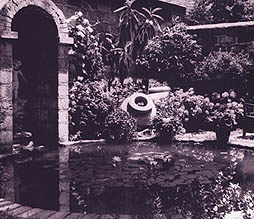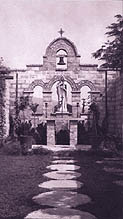


Epiphany Mission
Episcopal Church
62 Mountain Ave West
Sherwood, Tennessee 37376
(931) 598-5753
Rev. Lucy Shetters, CSM — Vicar
Episcopal Church
62 Mountain Ave West
Sherwood, Tennessee 37376
(931) 598-5753
Rev. Lucy Shetters, CSM — Vicar

Nestled in a scenic valley of the southern Cumberland Mountains of Tennessee in the small community of Sherwood is Epiphany Mission Episcopal Church. People from across the country would visit the little stone church and its walled garden with pools, bricked walkways, multitude of flowers, and open-air chapel.
Father Joseph S. Huske was the new priest-in-charge. The Mission had been the life’s work of Father George W. Jones from 1932 until his death in 1952. The Mission provided a place of worship, taught the religion of the Church, helped feed and clothe the poor, and tended the sick. But in 1932, during the early days of the Depression, the Episcopal Diocese of Tennessee could not supply money for the Mission. To support the Mission and its work, Father Jones enlisted the aid of what he affectionately called "The Greater Congregation". Composed of individuals that lived beyond the valley from across the country, they were friends and benefactors to the Mission providing money and "boxes" (boxes of cloths, shoes, books, and other items that could be used by the needy as well as the church). Also in 1932, Father Jones began publishing The Booklet, a report of the Mission activities and the needs of the people that it served.
The Mission Garden was started in 1938 by Father Jones to bring color, beauty, and inspiration to the people of Sherwood. Built by the young boys of the Mission over a number of years, the garden was also a way to occupy idle time and to provide needed income (although the pay was small). A field across the street from the church was cleared of cinders and fertile soil hauled in by wheelbarrow. Walls and walkways were built with blocks and brick that were cast by the boys on the spot. The boys constructed the garden and then the youths became the gardeners who tended the garden day to day. In the words of Father Jones, "A garden belongs to the Mission … the shepherd of souls is the chief gardener, but the Mission youths are the gardeners who toil."
It would become a walled garden covering an area of 16,000 square feet in a Spanish mission style. The centerpiece of the garden was the open-air chapel where Mass was sometimes held during the summer months. The chapel had an altar and a large statue of Mary holding the infant Lord. It would become known as "Our Lady of the Hills" chapel.


Photos on this page show the church in the 1940s.
Top: Photo from The Booklet, courtesy of John Lynch.
Left: One of several pools that were in the Mission Garden. Photo from The Booklet, courtesy of John Lynch.
Right: Our Lady of the Hills open-air chapel, c 1940s. The chapel was enclosed in a double-walled colonnade. Photo courtesy of Clyde Garner.